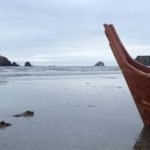 Alberni to Qualicum
Alberni to Qualicum
A trading trail across the lake and the mountains
Project start: 2012
Hypotheses at: Nov 2016
A. a. Route Archaeology/History – Pre-contact, fur-trading, colonial, early provincial eras
- The squiggle of the line on 1856 survey (plus associated clues in the historical record – canoes kept at both ends of the lake) suggests that the trail was the lake (ie. the lake was the portage between two trail sections over the mountain pass). Thus, discovery may influence Qualicum, K’omox, and Tseshaht First Nations treaty claims.
- Vancouver Island’s pre-contact islanders used an inland canoe, and this aspect of traditional Vancouver Island culture at the lake could be restored to canoe history.
- There are archaeological sites and/or artifacts at either end of the lake.
- There are archaeological sites and/or artifacts in the depths of the lake.
Evidence Testing – Sub-hypotheses:
Air, satellite and cartographic remote sensing imagery, and oral histories can be used to determine the pre-historic trail route and reported archaeological sites.
Ground-truthing, site archaeology, dive archaeology. With help from a ready pool of summer “dig site” volunteers, if opportunities are offered through District’s Horne Lake Regional Park and Horne Lake Provincial Park. Caving club divers would be a natural source of expertise for guided archaeological investigation of the lake-bed.
- The trail’s portage sites look to be near the east and southwest ends of the lake.
- The western edge (now provincial and regional parks) will be deeply disturbed by post-colonial logging from 1870s to present era.
- High-value data might be obtained between the southwest end and Port Alberni, where the trail led over the crest of View Mountain to descend into the valley.
A. b. Canoe Archaeology – The Pre-contact inland canoe
- After 1856, local guides took Crown officials to the Lake and showed them the canoes at either end, but the officials wanted to go around the lake on foot.
- We don’t know if the guides originally used an ‘ocean-going canoe’ brought to the lake, an inland canoe design, or got the canoe idea from HBC coeur des bois fur traders.
- But do know that later colonial visitors were surprised to find “Indian” canoes at either end of the lake, when there was a trail passage that was available to be used.
Evidence Testing – Sub-hypotheses:
- Pre-contact islanders used an “inland-style” of canoe at the lake.
- This aspect of traditional Vancouver Island culture could be restored to local First Nations history and the canoe story of Canada.
- Evidence Testing:
- Archival records
- Oral histories
B. Ecology
- If the shoreline characteristics of 2016 are significantly different from 1856, then post-colonial public works, and industrial and commercial impacts significantly altered the shoreline and ecological dynamics of the Qualicum River watershed and the Lake.
C. Commerce
- 1856 trail route will not affect the proposed Highway 4 Connector.
- In fact, it may give greater certainty to the archaeological record, since R.F.Binnie report notes that “Archaeological impacts are not known (S.4.4, p.36).
- 1856 route:
- Does not look to be close to the proposed route (Binnie, p.13).
- There may be one contact near a bend in the Big Qualicum River.
- We have no record of the actual 1872 waggon route thus far:
-
- Pemberton recommended a route on the south side of the lake because of soil conditions on the north side.
- Thus, the 1872 may not affect pre-contact route.
- 1872 route fell into disuse when the Cameron Lake waggon road came into use
- Cameron road later re-routed to accommodate railway and much later got renamed Hwy #4.
⊗ Archaic spelling.